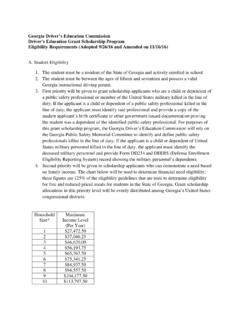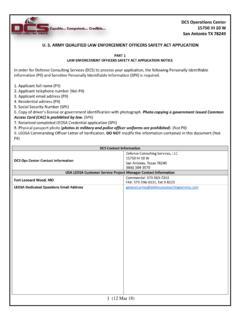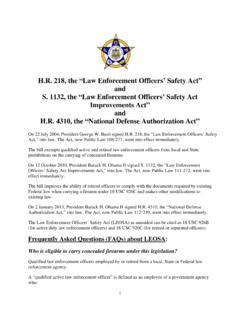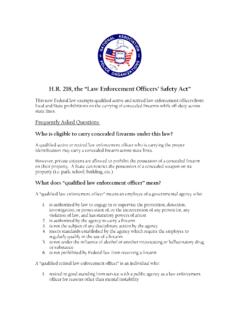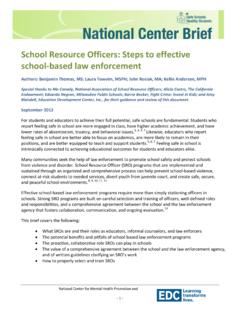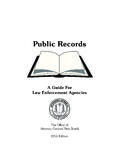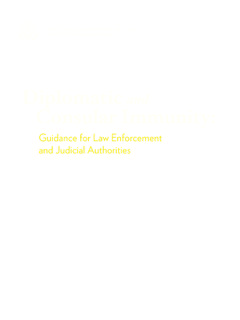Transcription of GEORGIA BICYCLE LAW ENFORCEMENT POCKET …
1 GEORGIA BICYCLE . LAW ENFORCEMENT . POCKET guide . A review of GEORGIA 's BICYCLE traffic laws to help with warnings, citations, and crash reports. 1st edition, January 2006. All citations are to the 2005 GEORGIA Code Bicycles are vehicles Table of Contents 1. The Challenge Of BICYCLE Traffic ENFORCEMENT ..1. 2. What To Enforce ..4. 3. Vehicles & Traffic: Uniform Rules of the Road Synopsis ..5. Legal Status of Cyclist ..5. Passengers ..6. Clinging to Vehicles ..7. Riding on Roadways and BICYCLE Paths ..7. Carrying Articles ..8. Lights and Other Equipment ..9. BICYCLE Helmet ..10. Obedience to Traffic Control Devices ..11. Stop Signs and Yield Signs ..11. Signaling a Turn or Stop ..13. Overtaking and Passing Generally ..13. When Overtaking and Passing on the Right is Permitted ..14. Vehicle Turning Left.
2 15. 4. Other Laws For Drivers ..16. Reckless Driving ..16. Aggressive Driving ..16. Driving Under the Influence ..17. Leaving the Scene of an Accident ..17. 5. BICYCLE Crash Investigation ..20. In General ..20. The Cyclist ..21. The Motorist ..22. Fatalities and Incapacitating Injuries ..22. 1. The Challenge of BICYCLE Traffic ENFORCEMENT Operating in traffic is a cooperative activity, gov- erned by rules. Traffic rules incorporate practices found, through collective experience, to facilitate safe and efficient travel. Since not everyone has enough experience or education to appreciate the rationale of the rules, seasoned and informed ENFORCEMENT is necessary to help instill safe habits. Officers exercise discretion in ENFORCEMENT actions;. an effective officer is prepared to explain the princi- ples involved when a cyclist or motorist uses poor judgment.
3 Key traffic principles for cyclists include: A cyclist is safer riding with traffic than facing it. A cyclist who rides facing oncoming traffic increases his risk of being hit by a motorist by two to four times. Drivers entering and exiting the roadway at side streets and driveways do not expect BICYCLE traffic to approach from the wrong direction. A front light must be used on a BICYCLE after sunset to alert other drivers. Frontward illumination is needed to alert drivers and on-coming traffic. A rear reflector is also needed. Additional lighting can be utilized. 1. Nighttime collisions are much more likely to result in an incapacitating injury or death. According to the GEORGIA DOT, about 46 percent of fatal BICYCLE crashes in GEORGIA occur during non-daylight hours (even with fewer cyclists riding then).
4 Five percent of BICYCLE crashes occurring during non- daylight hours result in fatalities compared to one percent of crashes in daylight hours. A cyclist traveling more slowly than other traffic should ride to the right, except to pass, to make a left turn, when necessary to avoid hazards, or when a lane is too narrow to share. A cyclist should ride to the right to facilitate pass- ing by faster vehicles, but should follow a pre- dictable line. A cyclist may leave the right-most side of the roadway when (1) moving as fast as other traffic, (2) passing another vehicle, (3) mak- ing a left turn, (4) avoiding roadside hazards, (5). where a lane is too narrow for a BICYCLE and another vehicle to travel safely side by side in the same lane. (Moving left in such a lane helps cue an overtaking driver who might otherwise mis- judge passing space.)
5 Cyclists on roadways fare best when they act and are treated as drivers of vehicles. Nationally, only about 30 percent of BICYCLE injuries 2. treated in emergency rooms involve collisions with motor vehicles and fewer than one in 700 BICYCLE injuries is fatal. Crashes in traffic are typically caused by avoidable errors. In 70 percent of police- reported BICYCLE -motor vehicle crashes, the cyclists involved had violated traffic rules; in about 45 per- cent, motorists had violated the rules. Riding as far as possible from other traffic ( , by riding on a sidewalk) increases crash risk by removing the cyclist from areas where motorists expect to see and encounter vehicular traffic. Note that sidewalk cycling entails a set of additional movement con- flicts and issues, and its legality varies much by jurisdiction, roadway, and age.
6 Notes _____. _____. _____. _____. _____. _____. _____. _____. 3. 2. What to Enforce In a national study,* the following violations were identified as common contributing factors in crashes involving bicycles and motor vehicles. Cyclist Riding against traffic on roadway ..15%. Failure to yield, entering roadway mid-block ..12%. Failure to yield at stop or yield sign ..10%. Cycling at night without lights ..10%. Failure to yield, signalized or uncontrolled intersection .. 7%. Motorist Failure to yield at stop or yield sign ..10%. Failure to yield, entering roadway from driveway ..7%. Failure to yield, turning left in front of oncoming cyclist ..6%. Failure to yield, signalized or uncontrolled intersection ..4%. Right turn in front of cyclist ..4%. * Hunter, Pein, and Stutts, BICYCLE Crash Types: A 1990's Informational guide , Report No.
7 FHWARD-96-104, Federal Highway Administration, 1997. 4. 3. Vehicles & Traffic: Uniform Rules of the Road Synopsis Citations are to the GEORGIA Motor Vehicles and Traffic: Uniform Rules of the Road Law (Title 40, Chapters 1 and 6, Official Code of GEORGIA Annotated). Any comments are shown in italic and parentheses (sample text). Legal status of cyclist [ 40-1 and 40-6]. A BICYCLE is defined as a vehicle [ 40-1-1(75)] (for purposes of the Uniform Rules of the Road Law). A. BICYCLE with an electric helper motor that cannot pro- pel it faster than 20 mph on level ground is included in this definition [ 40-1-1( )]. A person operating a BICYCLE is not required to have a driver's license [ 40-1-1(15)]. A person in control of a vehicle on a street or highway is a driver [ 40-1-1(14)]. (As a driver, a cyclist must follow the traffic rules common to all drivers.)
8 As the driver of a BICYCLE , she or he must also obey rules adopted specially for bicycles.). A cyclist has all of the rights to the roadway applicable to any driver, except as to the special regulations for bicycles [ 40-6-291, 292, 293, 294, 5. 295, 296, 297, 298]. Cyclists who violate traffic laws will be subject to the same penalties as drivers of motor vehicles, except that no penalty shall be assessed against a cyclist's motor vehicle driver's license. Infractions of BICYCLE regulations in Title 40 Motor Vehicles and Traffic, Chapter 6 Uniform Rules of the Road, Part 1 Bicycles and Play Vehicles, is a misde- meanor [ 40-6-298]. (For an infraction by a child cyclist, an officer could consider issuing a verbal or written warning.). Passengers [ 40-6-292]. No BICYCLE shall be used to carry more persons at one time than the number for which it is designed [ 40-6-292 (b)].
9 A BICYCLE may not be used to carry more persons at one time than the number for which it is designed or equipped; an adult bicyclist may carry a child in a sling, child seat or trailer designed to carry children [ 40-6-292 (c,d)]. Violations of subsections (c) and (d) of this Code section shall not constitute negligence or be consid- ered evidence of liability [ 40-6-292 (e)]. No person under the age of 16 years failing to comply with sub- 6. sections (c) and (d) may be fined or imprisoned [ 40-6-292 (f)]. [ 40-6-293]. Clinging to Vehicles No person riding a BICYCLE shall attach the same of himself to any vehicles upon the roadway [ 40-6- 293]. [ 40-6-294]. Riding on Roadways and BICYCLE Paths Every person operating a BICYCLE upon a road- way shall ride as near to the right side of the roadway as practicable except when turning left avoiding hazards to safe cycling when the lane is too narrow to share safely with a motor vehicle [ 40-6-294 (a)].
10 Roadway means that portion of a highway improved, designed, or ordinarily used for vehicular travel, exclusive of the berm or shoulder [ 40-1-1 (53)]. (A cyclist should maintain at least 18 to 24 inches of clearance from a curb or pavement edge [ GEORGIA DOT, GEORGIA Bike Sense guide ]. When parked vehicles exist on the roadway, bicyclists should ride 7. a predictable line outside the danger area. Since the recommended minimum clearance for passing a bicyclist (at moderate speed) is 3 feet [Governor's Office of Highway Safety and GEORGIA DOT, GEORGIA Bike Sense guide ] and the total width of larger motor vehicles (with extending mirrors) is commonly 8 feet or more, a lane with less than 14. feet of usable width is usually too narrow for motor traffic to pass. Moving to the left or even taking the center of the lanes is legal in the abovementioned circum- stances.)
